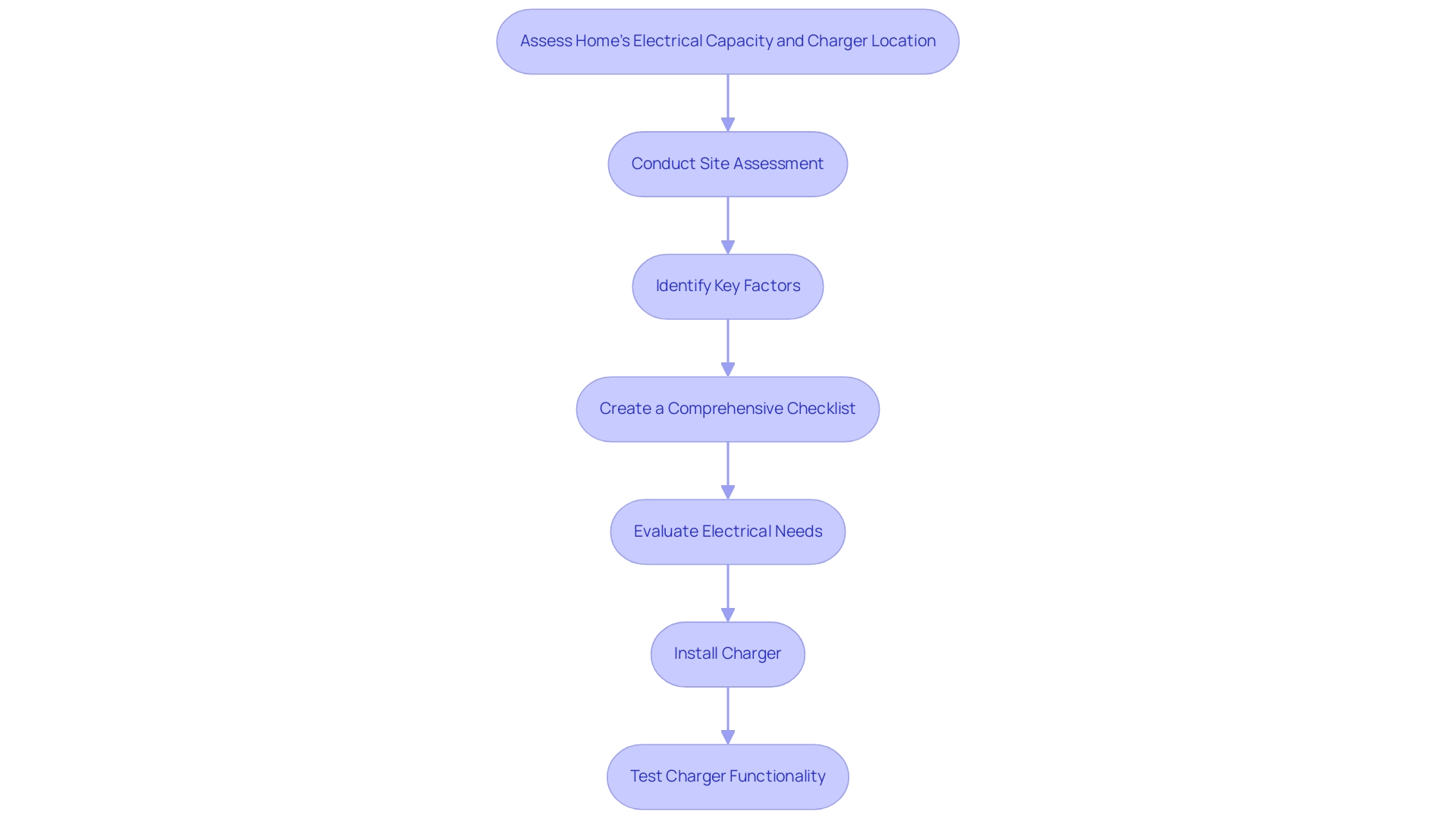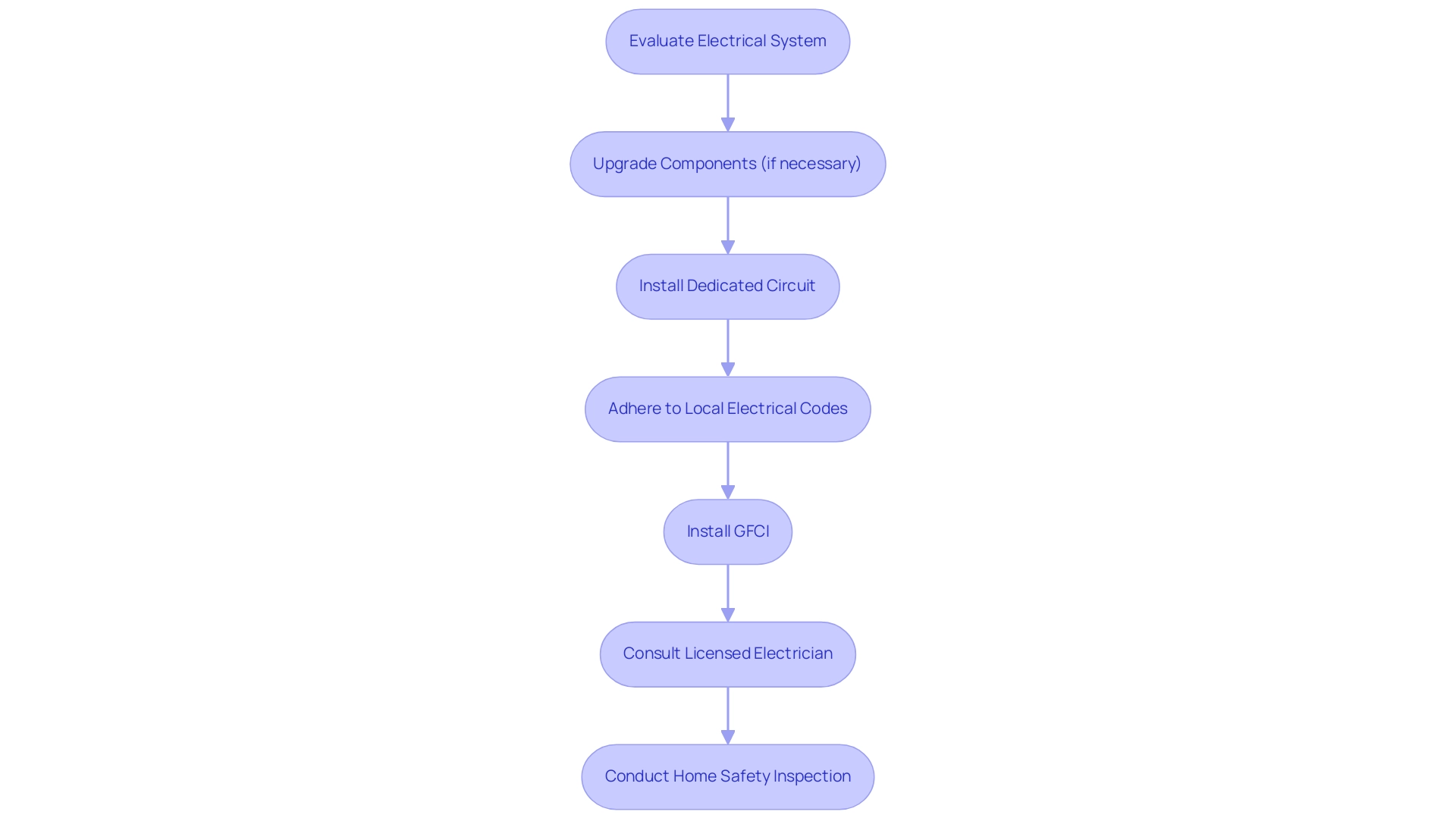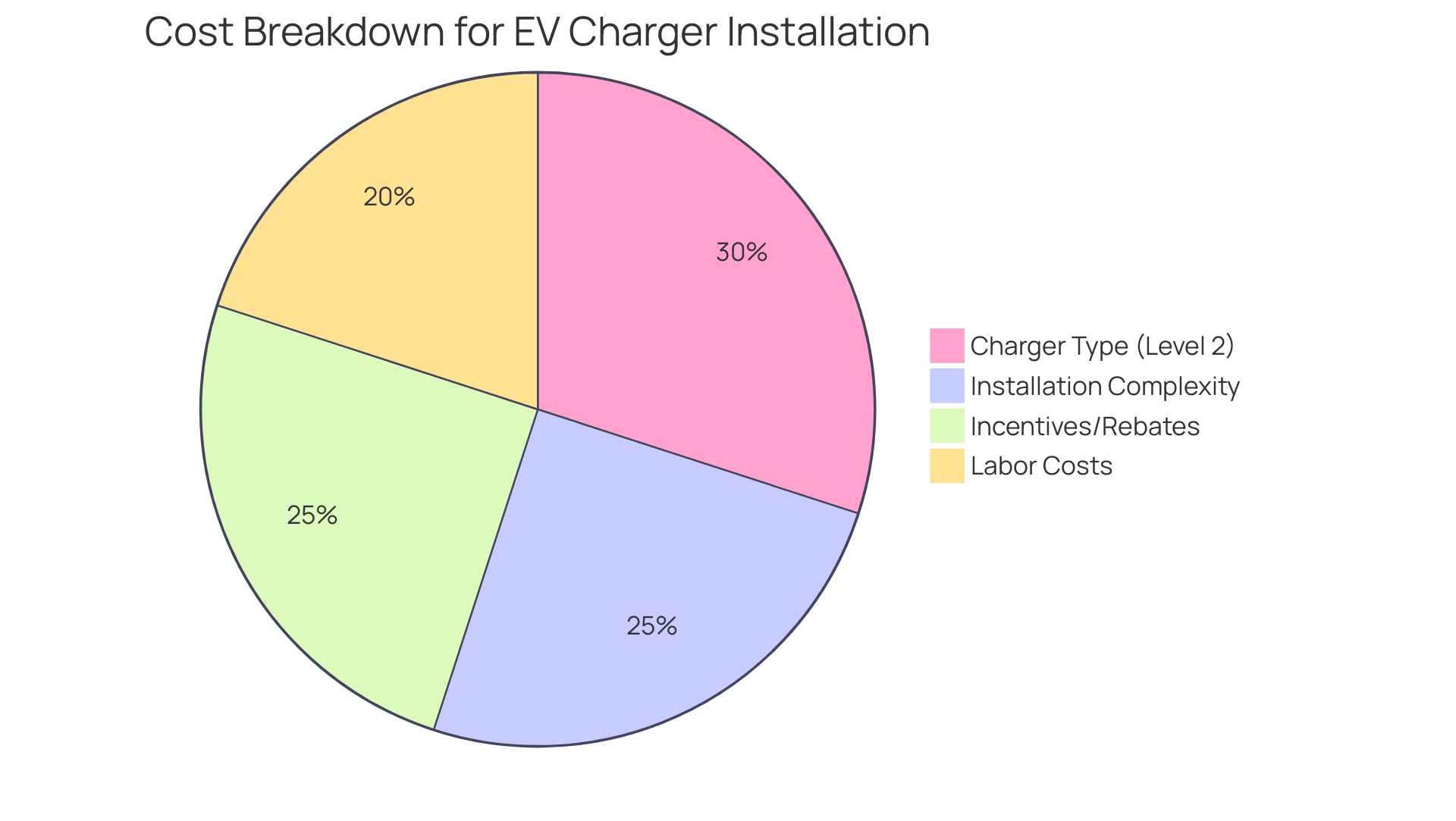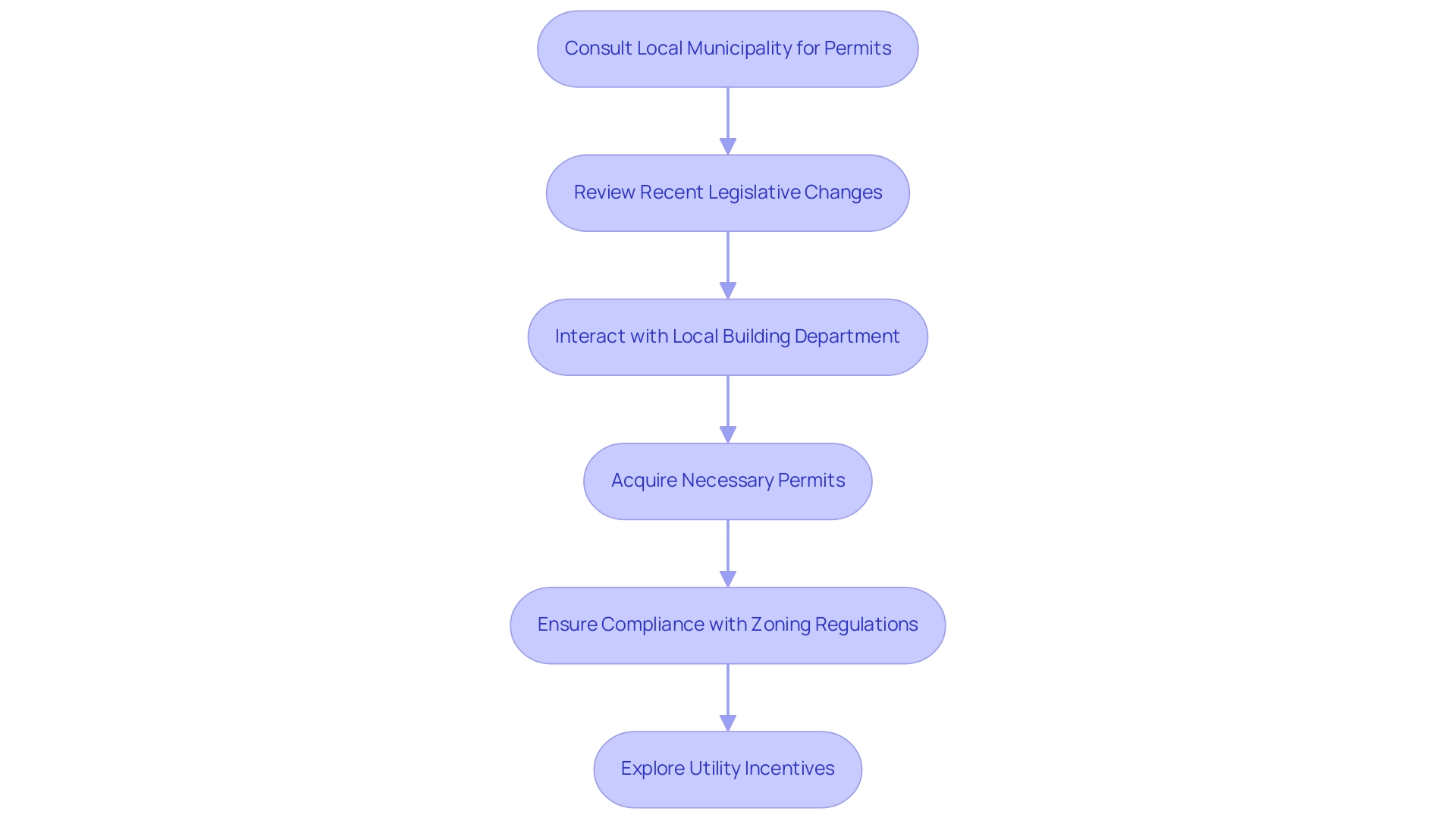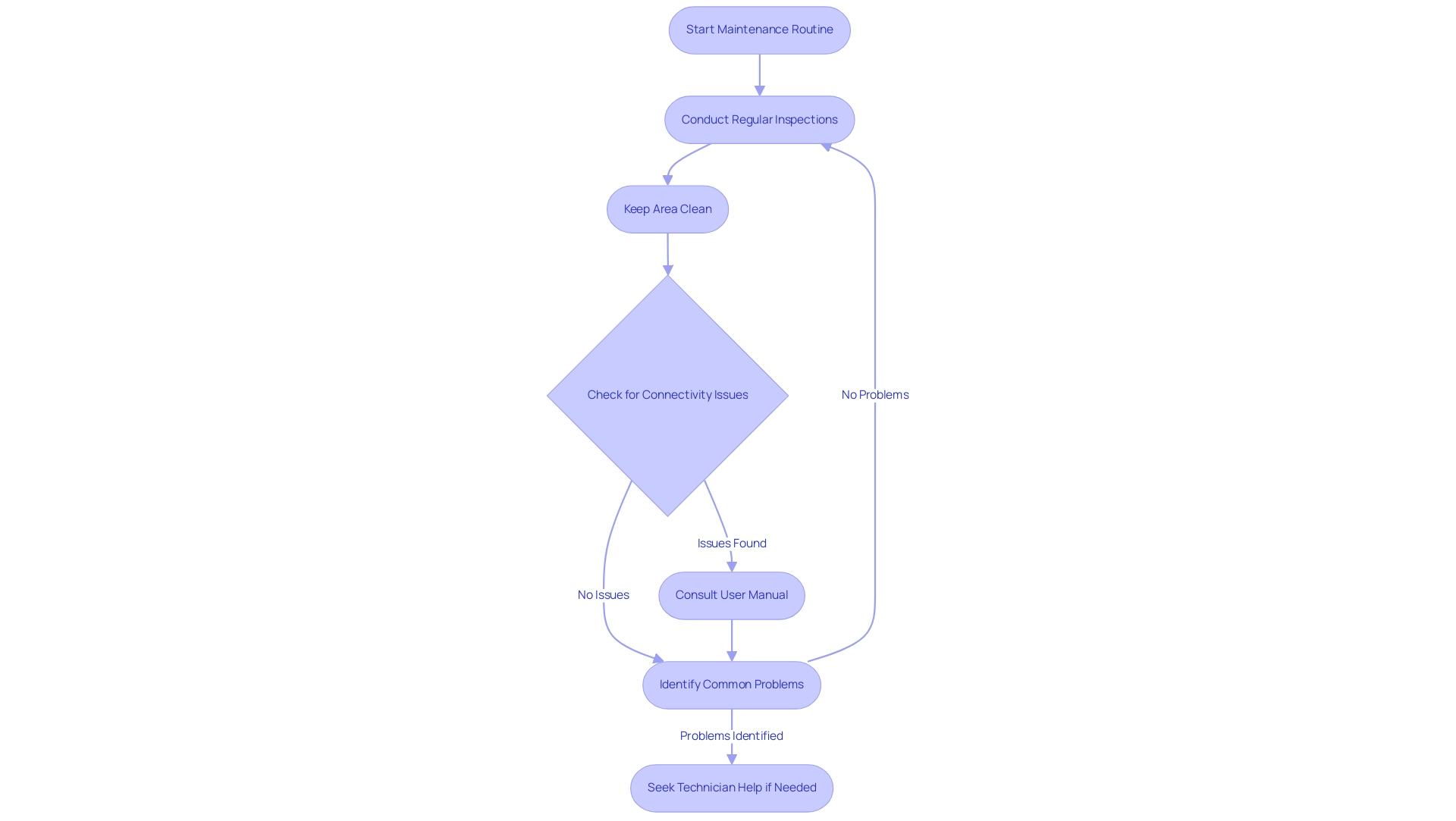Overview
To install an electric vehicle charger, homeowners should assess their electrical capacity, choose the appropriate charger type, and consider hiring professionals for compliance and safety. The article outlines critical steps, including evaluating site conditions, understanding local regulations, and ensuring proper electrical upgrades, emphasizing that professional installation can enhance safety and efficiency while potentially qualifying for financial incentives.
Introduction
As the world shifts towards sustainable transportation, understanding electric vehicle (EV) chargers becomes increasingly vital for both new and seasoned EV owners. With various charger types available, each tailored to specific needs, consumers are faced with the challenge of selecting the right one for their lifestyle.
From the slow but accessible Level 1 chargers to the rapid DC Fast Chargers designed for long-distance travel, the choices can be overwhelming. Additionally, the installation process, technical requirements, and ongoing maintenance play crucial roles in ensuring a seamless transition to electric mobility.
This article delves into the essential aspects of EV chargers, offering insights into their types, installation considerations, and the importance of proper maintenance, empowering homeowners to make informed decisions as they embark on their electrification journey.
Understanding Electric Vehicle Chargers: Types and Functions
Electric vehicle charging stations are categorized into three main types, each offering distinct advantages tailored to different user needs:
- Level 1 Devices: These units function on a standard 120V outlet, providing a slow replenishment rate that is typically appropriate for overnight use. They are frequently the most convenient choice for homeowners as they need minimal setup effort and cost. However, they may not be ideal for those with higher daily mileage.
- Level 2 Devices: Designed for a 240V outlet, Level 2 devices significantly decrease power-up durations, making them an excellent choice for home setups. With power rates that can restore a vehicle’s battery in just a few hours, these devices are perfect for electric vehicle owners seeking a dependable electric vehicle charger installation solution for everyday use. Their increasing market share reflects growing consumer preference for quicker power options. Notably, Level 2 chargers can operate at maximum powers of 1,500 V and 800 A, providing substantial energy delivery.
- DC Fast Chargers: Providing rapid charging capabilities, DC Fast Chargers are typically employed in commercial settings due to their high installation costs and power requirements. They are capable of delivering substantial power, which can recharge a vehicle to 80% in as little as 30 minutes, making them invaluable for long-distance travel. These devices can reach maximum specifications of 1,250 V and 3,000 A for MCS, showcasing their power potential. In 2023, the Australian Government announced funding of AUD 39.3 million to the National Roads and Motorists’ Association through the Driving the Nation Fund, aimed at constructing EV stations along national highways. This initiative demonstrates a dedication to improving EV infrastructure.
By recognizing the distinctions among these charging types, homeowners can make informed choices about electric vehicle charger installation that align with their driving habits and automobile specifications. Additionally, advancements in Electric Road systems (ERS) development in countries like Sweden and France, which are leading in this area, further support the transition to sustainable transportation. Sweden plans to electrify a highway by 2025, while France proposes nearly 5,000 km of ERS by 2030, showcasing a commitment to reducing emissions in road freight.
As the electric transport market evolves, these advancements in charging technology continue to enhance the efficiency and accessibility of these systems.
Planning Your EV Charger Installation: Key Considerations
To successfully execute electric vehicle charger installation, the first critical step is assessing your home’s electrical capacity and determining the optimal location for the charger. At Powercore Electric, we specialize in the comprehensive setup process for electric vehicle charger installation. Our team begins with a thorough site assessment to evaluate key factors important for the electric vehicle charger installation, such as:
- The proximity to your parking area
- Ease of access for your vehicle
- The distance to your electrical panel
Additionally, we examine the setup site for potential obstructions that could hinder access or visibility during the electric vehicle charger installation, ensuring the area is well-lit and safe for both day and night use.
Creating a comprehensive checklist can help streamline the electric vehicle charger installation process. Include essential requirements, such as:
- The availability of electrical access
- Any necessary upgrades to your home’s electrical system for electric vehicle charger installation
For instance, when considering electric vehicle charger installation for a Level 2 charger, be aware that the breaker for this circuit should exceed the circuit’s amperage by 20%—for example, an 80-amp circuit should use a 100-amp breaker.
Utilizing the appropriate breaker size improves safety by avoiding circuit overloads during electric vehicle fueling, which is essential for a successful installation and aligns with the Energy Commission’s dedication to attaining a 100 percent clean energy future.
After evaluating the site and implementing any required electrical enhancements, we proceed with the electric vehicle charger installation, ensuring it meets all safety and regulatory standards. Finally, we rigorously test the electric vehicle charger installation to ensure it’s functioning optimally before handing it over to you. As you gather this information, consider consulting with certified professionals for electric vehicle charger installation from Powercore Electric, known for their expertise and reliability in general electrical services.
Our team possesses the knowledge and experience to guarantee the setup process is efficient and meets all necessary safety standards, while also providing additional offerings such as solar panels and battery backups.
Technical Requirements for Installing Your EV Charger
Before moving forward with the electric vehicle charger installation, it is crucial to evaluate if your current electrical system can handle the extra load. This evaluation often necessitates upgrading components such as the circuit breaker or wiring to ensure optimal performance and safety. Our extensive setup procedure involves a detailed site evaluation to identify the optimal position for the device and to evaluate any electrical needs.
For the best results, the charger should be connected to a dedicated circuit, which can help prevent overloads and maintain efficiency. Adhering to local electrical codes is essential, as these regulations are intended to encourage safe setups. Additionally, we provide detailed electrical estimates to assist you in planning and budgeting effectively for the setup.
In alignment with safety best practices, the setup of a Ground Fault Circuit Interrupter (GFCI) is highly recommended to mitigate the risk of electrical shock. Consulting with a licensed electrician is essential for electric vehicle charger installation, as they can provide expertise on compliance with safety standards and help navigate the technical requirements. Our team at Powercore Electric specializes in electric vehicle charger installation, ensuring that all safety and regulatory standards are met throughout the process.
We also provide home safety inspections to identify potential hazards and recommend solutions.
Looking ahead, starting in 2024, all funded electric vehicle stations will need to comply with OCPP version 2.01 and ISO 15118 hardware standards, ensuring a standardized communication framework between EVs and the broader network. This initiative not only enhances safety but also establishes a national database for power stations, promoting data sharing while safeguarding user privacy and operational integrity. The case study titled ‘Future Compliance for Funded Charging Stations’ emphasizes the significance of following these standards, as they will be crucial in the development of EV infrastructure, ensuring that homeowners can depend on a strong and compliant network.
Additionally, it’s worth noting that the maximum power for ChaoJi chargers is 1,500 V and 800 A, which serves as a technical benchmark for homeowners considering electric vehicle charger installation. Powering stations, which serve as centralized sites with multiple power units for electric cars, further illustrate the expanding infrastructure supporting electric transport. As President of Qmerit Network aptly noted, ‘We’re here to make your electrification journey easy and provide a first-class experience with the highest quality of materials and service.’
By ensuring your electrical system is up to par, you not only comply with current safety standards but also prepare for future advancements in EV power technology.
Choosing Between Professional Installation and DIY: Pros and Cons
When planning for the installation of an electric vehicle charger, it’s essential to carefully consider both professional and DIY options:
- Professional Installation: Engaging a trained installer, such as Powercore Electric Inc., comes with the advantages of specialized expertise and warranty coverage, ensuring compliance with local codes and regulations. Powercore Electric has extensive experience in the industry, offering dependable electric vehicle charger installation services for EV power stations. In fact, Qmerit has set up over 450,000 electric vehicle charger installations in residences and enterprises throughout the U.S. and Canada, emphasizing the significance of expert installations in the industry. However, these benefits can lead to higher costs, with setup expenses starting under $1,000 but potentially exceeding $3,000 if electrical panel upgrades are necessary, as noted in the case study titled ‘EV Charging Setup Expenses.’ This investment is often offset by federal and state incentives. For inquiries or to schedule a consultation, you can contact Powercore Electric Inc. at ryan.serrano@powercoreinc.net or call (916) 699-8778.
- DIY Installation: Opting for a DIY approach can yield lower upfront costs and the rewarding experience of completing the project independently. Nevertheless, this route carries significant risks, particularly regarding safety. A lack of electrical knowledge can lead to hazardous situations, making it critical for individuals to assess their comfort level with electrical work. As noted by the Momentum Electrical Team, > Given that the shift to electric mobility is speeding up, with forecasts indicating yearly sales of electrified vehicles hitting 40 million by 2030, ensuring an effective and safe home power setup is becoming increasingly important <. Therefore, if there is any uncertainty regarding your electrical skills, hiring a professional like Powercore Electric for electric vehicle charger installation is advisable to ensure a safe and trustworthy setup. Comprehending these elements assists homeowners in preparing for a seamless setup process in both professional and DIY contexts.
Cost Analysis: Budgeting for Your EV Charger Installation
The expense of electric vehicle charger installation, particularly for a Level 2 charger, can vary greatly depending on multiple factors, such as the kind of charger chosen, the intricacy of the setup, and local labor costs. On average, homeowners may anticipate spending anywhere from $500 to $2,000 for the electric vehicle charger installation process. Various utility companies offer rebates and incentives that can considerably lower these costs.
Homeowners can take advantage of federal tax credits of up to $1,000, along with additional state and local rebates; it is essential to investigate the specific programs available in your area to maximize these financial incentives. Moreover, Greg Sowder, President of Qmerit Network, emphasizes the significance of professional electric vehicle charger installation, stating,
‘Rated #1 in customer satisfaction, Qmerit’s experienced network of certified electricians has completed the electric vehicle charger installation of more than 450,000 EV charging stations in homes and businesses across the U.S. and Canada!’
This emphasizes the importance of selecting qualified experts for the electric vehicle charger installation to ensure a seamless and efficient process.
Homeowners should also consider the differences in costs between indoor and outdoor electric vehicle charger installation; indoor setups are generally less expensive, typically ranging from $500 to $1,000 less than outdoor installations, which may require additional weather-resistant features and customized cable lengths. By planning ahead and budgeting effectively, homeowners can maximize their savings while transitioning to electric transportation ownership. Furthermore, combining electric transportation power sources with renewable energy options, like solar panels, can further improve efficiency and sustainability.
For instance, installing solar panels can offset the electricity expenses of powering an EV, making the transition more economical in the long run. Amy R. highly recommends the service for exceptional service and pricing, praising Tom’s helpfulness and straightforwardness, further reinforcing the importance of selecting a reputable installer.
Navigating Permits and Regulations for EV Charger Installation
Before moving forward with the electric vehicle charger installation, it is vital to consult your local municipality to determine if a permit is required, as many regions enforce specific regulations on EV charger setups. Recent legislative changes, effective October 1, 2023, mandate that new housing units with garages, carports, or driveways must include an EV supply equipment parking space for Level 2 charging or an EV-ready parking space that adheres to defined electrical standards. Interacting with your local building department is essential for acquiring the necessary permits and ensuring adherence to zoning regulations, which helps reduce potential penalties and guarantees a safe setup process.
Powercore Electric Inc. provides a variety of services associated with electric vehicle charger installation, including site evaluations, equipment suggestions, and comprehensive support, ensuring a smooth experience for homeowners. Notably, Qmerit has successfully set up over 450,000 electric vehicle charger installations, underscoring the growing demand for electric vehicle charger installation. Homeowners should also explore various utility incentives and financing options available to offset costs, making setup more affordable.
For example, numerous local utility firms offer rebates for EV charging setups, which can greatly lower the total cost. Furthermore, ensure that all DPS-issued permits are attached to the project and that approved plans are accessible for inspector review. As construction manager Carlos Iraheta wisely notes, ‘The City has the right to refuse a permit if conditions cannot be met or for reasons not listed.’
Following these regulations not only enables a smoother electric vehicle charger installation but also ensures compliance with local building codes and the latest requirements for EV equipment installations in 2024.
Post-Installation: Maintenance and Troubleshooting Your EV Charger
Proper maintenance of your electric vehicle (EV) charger is essential to ensure its longevity and performance, especially as the infrastructure for electric vehicles continues to expand. France’s suggestion for almost 5,000 km of Electric Road systems by 2030 emphasizes the rising investment in EV infrastructure, which will probably boost the need for dependable power solutions. At Powercore Electric, we specialize in the comprehensive setup process for electric vehicle charger installation, starting with a thorough site assessment to determine the best location and evaluate electrical requirements.
If your current infrastructure requires enhancements, we will adjust it accordingly to support your new device. After installation, we conduct rigorous testing and commissioning to ensure optimal functionality before handing it over to you.
To keep your device in top shape, begin by conducting regular inspections for any signs of wear or damage. Keeping the surrounding area clean and free from debris is equally important, as it helps prevent potential hazards. If you experience issues such as connectivity problems or failure to charge, the first step is to consult the user manual for specific troubleshooting tips.
Common challenges include faulty connections or software glitches. If these issues continue, it’s recommended to seek help from a qualified technician to prevent further complications.
Recent statistics indicate that well-maintained EV charging stations have a significantly lower failure rate, with maintenance best practices contributing to a 30% increase in operational efficiency. According to Alex Morgan, a principal researcher, effective maintenance is crucial, especially as Tesla maintains a 48.2% market share in the EV sector as of Q3 2024. Additionally, insights from case studies reveal that access to home power sources varies significantly across regions, which underscores the importance of maintaining chargers in areas where home power availability is limited.
In densely populated areas, the dependence on public power sources may heighten the importance of having well-maintained EV chargers.
For optimal performance, consider adopting maintenance routines that include checking the firmware for updates and ensuring the power cable is in good condition. Furthermore, the presence of charging hubs, which are centralized locations equipped with multiple charging stations for EVs, may influence maintenance practices and user experiences. By following these guidelines, you can mitigate common problems and extend the lifespan of your EV charger significantly.
For more information about electric vehicle charger installation or maintenance services, feel free to reach out to us at Powercore Electric at ryan.serrano@powercoreinc.net or call us at (916) 699-8778.
Conclusion
Understanding the landscape of electric vehicle (EV) chargers is essential for both current and prospective EV owners. This article has explored the various types of chargers available—Level 1, Level 2, and DC Fast Chargers—highlighting their unique features and suitability for different lifestyles. Each charger type serves distinct needs, from the accessibility of Level 1 chargers for casual users to the rapid capabilities of DC Fast Chargers for long-distance travelers.
Furthermore, the installation process is crucial in ensuring that homeowners can seamlessly integrate these chargers into their electrical systems. Key considerations include:
- Assessing electrical capacity
- Understanding technical requirements
- Navigating local regulations
All of which contribute to a successful installation. Whether opting for professional installation or a DIY approach, understanding the pros and cons helps homeowners make informed decisions that prioritize safety and efficiency.
Cost analysis reveals that while installation expenses can vary, financial incentives such as rebates and tax credits can significantly offset these costs. Planning ahead not only aids in budget management but also enhances the transition to electric vehicle ownership. Lastly, ongoing maintenance is vital for ensuring the longevity and performance of EV chargers, especially as infrastructure continues to evolve.
As the demand for electric vehicles grows, so too does the importance of selecting the right charger and ensuring its proper installation and maintenance. By staying informed and proactive, homeowners can embrace the shift toward sustainable transportation, ensuring a smooth and efficient electrification journey that aligns with their needs and lifestyle.




